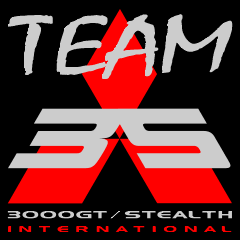
New York - Munich - Portland - San Francisco - Seattle - Stockholm - Vancouver - Zurich
International HQ: 273 Fifth Avenue, NYC 10016

New York - Munich - Portland - San Francisco - Seattle - Stockholm - Vancouver - Zurich
International HQ: 273 Fifth Avenue, NYC 10016
Here are some terms that are specific to our cars:
![]()
{Items with the 'FAQ' symbol are discussed in greater detail
at the bottom of this page.}
3S = 3000GT/Stealth. Also 3/S, S3, S3k, S/3k...
(The metric k = kilo = 1000, so 3k =3000)
ABS = Anti-Lock Braking System
AFC = Air-Fuel Controller
![]() AWD, 4WD = All Wheel Drive, 4-wheel Drive
AWD, 4WD = All Wheel Drive, 4-wheel Drive
![]()
AFR = Air Fuel Ratio
AWS = All-Wheel Steering
BADC = Boost Actuator Duty Cycle
BC = Boost Controller
BDC = Bottom Dead Center (ref: Timing Settings)
BOV = Blow-Off Valve (Slang - what we call BPV)
BPV = By-Pass Valve (Mitsubishi's term for BOV - see above)
BTDC, (ATDC) = Before Top Dead Center, (AfterTDC)
(Timing setting, expressed in degrees)
C.A.R.B. = California Air Resources Board
CAT = The catalytic converter
C/D or CD
=
Coefficient of Drag
(Somewhere between 0.29 and 0.33 for our cars)
DOHC = Double OverHead Cam
(The 24-valve engines in Stealth ES & R/T, 3000GT SL, all the turbos)
DSBC = Dual Solenoid Boost Controller
DSM = Diamond Star Motors
(Group that made the Eclipse/Talon/Laser, aka 'DSM's)
EBP = Exhaust Back Pressure
ECU = Electronics Control Unit (Engine Computer)
EGR (pipe) = Exhaust Gas Recirculation (pipe)
EGT = Exhaust Gas Temperature
ECS = Electronically Controlled Suspension
FIPK = Filter Injection Performance Kit
K&N's Filter System that replaces the stock air filter box
(Preferred system used by most owners - Good for + 10 to 15 HP)
FPR = Fuel Pressure Regulator
![]() GTO, GT = Grand Touring Car
GTO, GT = Grand Touring Car
![]()
(from the Italian, 'Gran Turismo Omologato')
IDC = Injector Duty Cycle
IPW = Injector Pulse Width (dataloggers report this, in milliseconds)
MAF, MAS = Mass Air Flow Sensor, Mass Air Sensor
(Unit that analyzes airflow, found directly behind the air filter housing).
MHI - Mitsubishi Heavy Industries (manufacturer of our turbos)
NT = Non-Turbo (or NA = Normally aspirated)
NA = Normally Aspirated ( or NT = Non-Turbo)
![]() OBD = On-Board Diagnostics
OBD = On-Board Diagnostics
![]()
PCV = Positive Crankcase Recirculating Valve/Hose
SOHC = Single OverHead Cam
(The 12-valve engines on Stealth & 3000GT Base models)
TDC = Top Dead Center (ref: Timing Settings)
TOB = Throw-out bearing (clutch assembly)
TRE MASC = Team Rip Engineering Mass Air Sensor (and) Controller
TT = Twin Turbo
VC = Viscous Coupling
WOT = Wide Open Throttle ('Flooring It')
![]()
FAQ: 3S Acronyms - Some More Detail
|
Q.>>>:
What does the term 'URL' mean? ...details, please?
Q.>>>:
What does the term 'GTO' mean? ...How about 'GT'?
Q.>>>:
What are OBDI and OBDII?
Q.>>>:
What's the difference between AWD and 4WD? |
![]()
![]()
![]()
